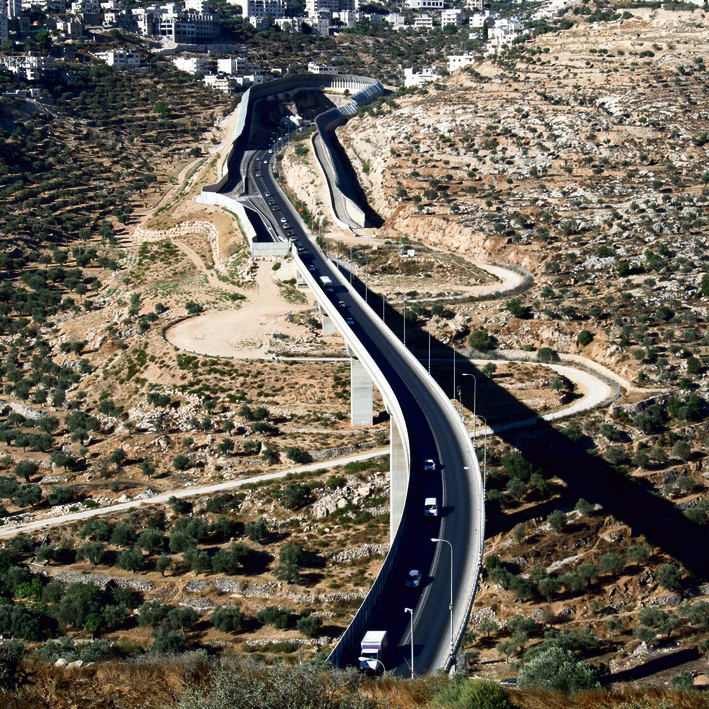
Heavy traffic on the way to Jerusalem
Photo: Gil Yohanan

West Bank roads to receive NIS 5 billion upgrade
Five-year plan expected to help ease traffic congestion in the area, especially at entrances to Jerusalem, and make the roads safer; Transportation Minister Katz says massive upgrade to infrastructure will help the Jewish settlements further expand and develop.
The Israeli government has launched a new five-year plan to upgrade the transportation infrastructure in the West Bank to the tune of NIS 5 billion ($1.3 billion).
The massive project, led by Transportation Minister Yisrael Katz, will include excavating new tunnels, expending main highways, road resurfacing, paving interchanges, new access roads and bypasses, and creating easier access to the Tel Aviv and Jerusalem metropolitan areas via light rail and special public transit lanes. The new public transit lanes are meant to help reduce the traffic congestion on the roads leading into the metropolitan areas.
The roads in the West Bank see constant traffic of both Israeli and Palestinian vehicles 24 hours a day. However, the infrastructure in many places is lacking, with narrow roads often leading to fatal car accidents. The roads leading to the Jerusalem and Tel Aviv metropolitan areas are also plagued by heavy traffic. The five-year plan seeks to both make the roads safer and ease the congestion.
In the Jerusalem metropolitan area, an emphasis will be put on reducing the heavy traffic at the eastern, southern and northern entrances to the city, so the capital and its surrounding area become one metropolis with a quick and direct connection to Ma'ale Adumim, Givat Ze'ev, Gush Etzion-Binyamin and Beitar Illit.
To that end, the Tunnels Road (the Jerusalem portion of Highway 60) will undergo a NIS 850 million expansion in the area between Begin Boulevard (Highway 50) and Elazar (on Highway 60), adding a lane in each direction as well as a public transit lane.
The project will open up the possibility of adding new housing units in Beit Shemesh, Beitar Illit, Tzur Hadassah and the surrounding area. It will give drivers a direct route from Gush Etzion to Tel Aviv through Jerusalem without stopping at a single traffic light.
The Transportation Ministry has already allocated NIS 30 million to the project's planning and work is scheduled to will begin at the end of 2018.
A grade separation is going to be built at the French Hill Junction at the cost of NIS 1 billion. It will include two two-laned tunnels going east to west, 1.5 kilometers in length and two one-lane tunnels going north to west, which will be 650 meters in length.
The Transportation Ministry has already allocated NIS 80 million to the project's planning and work is scheduled to will begin at the end of 2018.
When the project is completed, drivers will be able drive directly from Ma'ale Adumim to Jerusalem or Tel Aviv without stopping at a single traffic light.
The Transportation Ministry is also looking into either a light rail or a train connecting Ma'ale Adumim to Jerusalem.
Furthermore, the ministry is working on solutions for the traffic congestion in the Qalandiya area that would affect all entrances to Jerusalem from the north.
In the first stage, a public transit lane will be paved from Qalandiya to Jerusalem, budgeted at NIS 30 million. Then, a grade separation will be built as well as a new road connecting the Binyamin area to Route 443 through the town of Atarot.
The total cost of the project will be NIS 80 million. The Transportation Ministry has already allocated NIS 5 million to planning the project.
Some NIS 50 million were invested in the eastern ring road, which will connect the northern part of Jerusalem to the Naomi Shemer Mount Scopus Tunnel and Ammunition Hill. Route 437 will be expanded with a public transit lane from the Adam Junction to the light rail station in Pisgat Ze'ev.
The plan also includes a light rail that would connect the settlement of Ariel and the Samaria region to the Greater Tel Aviv metropolitan area. The light rail will go from Ariel towards Rosh HaAyin and Petah Tikvah.
In addition, Route 55 will be doubled from Karnei Shomron to where it links up with Route 444.
Several roads will be paved to bypass roads that pass through Arab villages. A road to bypass Nabi Ilyas is being paved as part of Route 55 to the tune of NIS 54 million, while a road to bypass Al-Arroub, which will connect the Judea region to Kiryat Arba-Hebron and Jerusalem, is in the planning stages. In addition, a road to bypass Huwara is being planned to better connect the northern Samaria region to Ariel and to central Israel.
The existing road from Modi'in Illit to the Lapid Junction will also be doubled and later, an interchange will be paved near Shilat as well as another direct road from Modi'in Illit to the Maccabim Junction on Route 443.
The plan also has projects that are in the primary stages and will be carried out as part of the next five-year plan, which will include the completion of the planning stages for the expansion of Route 60 from the Tapuach Junction to Meitar as a four-lane road with two lanes in each direction, as well as expanding and completing routes 465 and 446, among others.
As part of the plan, dangerous roads where fatal car accidents have occurred will be added with new safety measures. In the first stage, junctions along Route 60—including the Givat Asaf junction, the Kokhav Ya'akov junction and the British Police junction—will be added with traffic lights, squares etc., based on need. Significant safety measures might be added to Route 444 connecting Anatot and Ma'ale Adumim. At a later stage, highway lights will be added to junctions across the West Bank.
Finally, Givat Ze'ev and Sha'ar Binyamin will be connected via train to the local train network being built in Jerusalem.
"The plan's objective is to improve accessibility and safety for both the Israeli and Palestinian populations," Transportation Minister Katz said.
The plan, he added, will bolster the Jewish settlement in the West Bank and allow it to develop further, much like the infrastructure upgrade being done in the Galilee and the Negev regions.
















